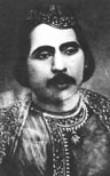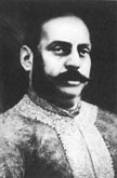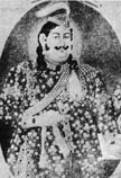


Kathak
Kathak, a major classical dance form of North India, literally means a storyteller or kathakar. In ancient India there were 'Kathakars' or bards who used to recite religious and mythological tales along with the accompaniments, music, mime and dance. This classical dance form which had its origin in simple story telling came to be known as 'Kathak'. What distinguishes kathak from other Indian classical dance forms is its spontaneity, freedom from uniformity and a lot of room for improvisation and innovations



Bindadin
KalkaPrasad
Wajid Ali Shah
At times there is a sort of concert during which the drummer
weaves and plays a complex design which in turn is danced by the
dancer, specially in the item which is technically known as 'Jugal
Bhandi'. It is a kind of friendly challenge and competition
between the two (dancer and drummer) which is full of
innovations and improvisation.
Kathak has been best preserved in the cities of Lucknow in Uttar Pradesh and Jaipur in Rajasthan. During the medieval period, kathak suffered a lot in stylization and formalization. Persian and Muslim influences made kathak from a temple ritual to a courtly entertainment. During this period it was called as 'Nautch'. Gradually from this the Kathak dance form evolved and gained much of its polish, grace and elegance. The contribution of Lucknow Gharana and Jaipur Gharana has been the greatest in the revival of kathak dance form
|
Guru Shambhu Maharaj |
Guru Birju Maharaj |
|
|
LUCKNOW GHARANA
- It began in later half of 19th century Nawab Wajid Ali
Shah of Audh was a great patron of Kathak and other arts. He
himself mastered the art and became an expert Guru (teacher)
of this art form. He learnt the art of kathak from the great
kathak exponent Shri Thakur Prasad Ji. His brother Durga
Prasad Ji was also a great kathak Guru. His son 'Bindadin'
took kathak to great heights by composing as many as 500
thumaris. His brother 'Kalka Prashad' was also a noted Guru
and scholar in kathak. He taught his three sons 'Acchan
Maharaj, Lachhu Maharaj and Shambhu Maharaj'. The well-known
kathak maestro 'Birju Maharaj' is the son of Acchan Maharaj.
JAIPUR GHARANA- the Jaipur Gharana goes back to middle of 19th century. Bhanuji was the first noted exponent. It is said that he got his training in this dance form from a saint but it was 'Giridhariji' who became one of the greatest masters of Jaipur Gharana Dance style. His two sons, 'Hari Prashad and Hanuman Prashad' led kathak to new heights of technical brilliance, glory and aesthetic beauty. Later, Chiranji Lal, Narain Prashad, Mohan Lal, Jai Lal and Sundar Prashad followed them. Hanuman Prashad was well known for his 'Lasya' (soft or feminine) style of kathak and Hari Prashad excelled in Tandava (hard or masculine) style of kathak. Guru MayaRao studied under both Jaipur and Lucknow Gharanas under Shambhu Maharajji and Guru Sunder Prasad. |
||